Simulation of On-Chip Broadband Photon Spin Router Base on Nondiffracting Surface Plasmon Beam Launching
Abstract
:1. Introduction
2. Principle and Simulation Results
3. Multi-Nondiffracting SPP-Beam Launching
4. Simulation of Practical Spin Routing Device
5. Conclusions
Author Contributions
Funding
Institutional Review Board Statement
Informed Consent Statement
Conflicts of Interest
References
- Kim, S.-J.; Yun, H.; Park, K.; Hong, J.; Yun, J.-G.; Lee, K.; Kim, J.; Jeong, S.J.; Mun, S.-E.; Sung, J.; et al. Active directional switching of surface plasmon polaritons using a phase transition material. Sci. Rep. 2017, 7, 43723. [Google Scholar] [CrossRef] [Green Version]
- Yang, Z.; Fu, Y.; Yang, J.; Hu, C.; Zhang, J. Spin-encoded subwavelength all-optical logic gates based on single-element optical slot nanoantennas. Nanoscale 2018, 10, 4523–4527. [Google Scholar] [CrossRef] [PubMed]
- Fu, Y.; Hu, X.; Lu, C.; Yue, S.; Yang, H.; Gong, Q. All-Optical Logic Gates Based on Nanoscale Plasmonic Slot Waveguides. Nano Lett. 2012, 12, 5784–5790. [Google Scholar] [CrossRef]
- Feng, F.; Si, G.; Min, C.; Yuan, X.; Somekh, M. On-chip plasmonic spin-Hall nanograting for simultaneously detecting phase and polarization singularities. Light. Sci. Appl. 2020, 9, 95. [Google Scholar] [CrossRef] [PubMed]
- Chen, J.; Chen, X.; Li, T.; Zhu, S. On-Chip Detection of Orbital Angular Momentum Beam by Plasmonic Nanogratings. Laser Photon- Rev. 2018, 12. [Google Scholar] [CrossRef]
- Kim, H.; Park, J.; Cho, S.-W.; Lee, S.-Y.; Kang, M.; Lee, B. Synthesis and Dynamic Switching of Surface Plasmon Vortices with Plasmonic Vortex Lens. Nano Lett. 2010, 10, 529–536. [Google Scholar] [CrossRef]
- Yang, S.; Chen, W.; Nelson, R.L.; Zhan, Q. Miniature circular polarization analyzer with spiral plasmonic lens. Opt. Lett. 2009, 34, 3047–3049. [Google Scholar] [CrossRef]
- Moon, S.-W.; Jeong, H.-D.; Lee, S.; Lee, B.; Ryu, Y.-S.; Lee, S.-Y. Compensation of spin-orbit interaction using the geometric phase of distributed nanoslits for polarization-independent plasmonic vortex generation. Opt. Express 2019, 27, 19119–19129. [Google Scholar] [CrossRef]
- Tanemura, T.; Balram, K.C.; Ly-Gagnon, D.-S.; Wahl, P.; White, J.S.; Brongersma, M.L.; Miller, D.A.B. Multiple-Wavelength Focusing of Surface Plasmons with a Nonperiodic Nanoslit Coupler. Nano Lett. 2011, 11, 2693–2698. [Google Scholar] [CrossRef]
- Liu, H.; Deng, H.; Deng, S.; Teng, C.; Chen, M.; Yuan, L. Vortex Beam Encoded All-Optical Logic Gates Based on Nano-Ring Plasmonic Antennas. Nanomaterials 2019, 9, 1649. [Google Scholar] [CrossRef] [Green Version]
- Zhao, H.; Zhang, J.; Liu, G.; Tansu, N. Surface plasmon dispersion engineering via double-metallic Au/Ag layers for III-nitride based light-emitting diodes. Appl. Phys. Lett. 2011, 98, 151115. [Google Scholar] [CrossRef] [Green Version]
- Yuan, G.H.; Wang, Q.; Tan, P.S.; Lin, J.; Yuan, X.-C. A dynamic plasmonic manipulation technique assisted by phase modulation of an incident optical vortex beam. Nanotechnology 2012, 23, 385204. [Google Scholar] [CrossRef] [PubMed]
- Tan, Q.; Xu, Z.; Zhang, D.H.; Yu, T.; Zhang, S.; Luo, Y. Polarization-Controlled Plasmonic Structured Illumination. Nano Lett. 2020, 20, 2602–2608. [Google Scholar] [CrossRef]
- Zang, X.; Mao, C.; Guo, X.; You, G.; Yang, H.; Chen, L.; Zhu, Y.; Zhuang, S. Polarization-controlled terahertz super-focusing. Appl. Phys. Lett. 2018, 113, 071102. [Google Scholar] [CrossRef]
- Wang, S.; Wang, X.; Kan, Q.; Qu, S.; Zhang, Y. Circular polarization analyzer with polarization tunable focusing of surface plasmon polaritons. Appl. Phys. Lett. 2015, 107, 243504. [Google Scholar] [CrossRef]
- Lin, J.; Mueller, J.P.B.; Wang, Q.; Yuan, G.; Antoniou, N.; Yuan, X.-C.; Capasso, F. Polarization-Controlled Tunable Directional Coupling of Surface Plasmon Polaritons. Science 2013, 340, 331–334. [Google Scholar] [CrossRef]
- Yang, J.; Xiao, X.; Hu, C.; Zhang, W.; Zhou, S.; Zhang, J. Broadband Surface Plasmon Polariton Directional Coupling via Asymmetric Optical Slot Nanoantenna Pair. Nano Lett. 2014, 14, 704–709. [Google Scholar] [CrossRef] [PubMed]
- Yao, W.; Liu, S.; Liao, H.; Li, Z.; Sun, C.; Chen, J.; Gong, Q. Efficient directional excitation of surface plasmons by a sin-gle-element nanoantenna. Nano Lett. 2015, 15, 3115–3121. [Google Scholar] [CrossRef]
- Guo, Q.; Zhang, C.; Hu, X. A spiral plasmonic lens with directional excitation of surface plasmons. Sci. Rep. 2016, 6, 32345. [Google Scholar] [CrossRef] [Green Version]
- Gao, Z.; Gao, F.; Zhang, B. Multi-directional plasmonic surface-wave splitters with full bandwidth isolation. Appl. Phys. Lett. 2016, 108, 111107. [Google Scholar] [CrossRef]
- Thomaschewski, M.; Yang, Y.; Wolff, C.; Roberts, A.S.; Bozhevolnyi, S.I. On-Chip Detection of Optical Spin–Orbit Interactions in Plasmonic Nanocircuits. Nano Lett. 2019, 19, 1166–1171. [Google Scholar] [CrossRef]
- Krauss, E.; Razinskas, G.; Köck, D.; Grossmann, S.; Hecht, B. Reversible Mapping and Sorting the Spin of Photons on the Nanoscale: A Spin-Optical Nanodevice. Nano Lett. 2019, 19, 3364–3369. [Google Scholar] [CrossRef]
- Kruk, S.S.; Decker, M.; Staude, I.; Schlecht, S.; Greppmair, M.; Neshev, D.N.; Kivshar, Y.S. Spin-Polarized Photon Emission by Resonant Multipolar Nanoantennas. ACS Photon- 2014, 1, 1218–1223. [Google Scholar] [CrossRef]
- Garcia-Ortiz, C.E.; Coello, V.; Han, Z.; Bozhevolnyi, S.I. Generation of diffraction-free plasmonic beams with one-dimensional Bessel profiles. Opt. Lett. 2013, 38, 905–907. [Google Scholar] [CrossRef] [Green Version]
- Wang, S.; Wang, S.; Zhang, Y. Polarization-based dynamic manipulation of Bessel-like surface plasmon polaritons beam. Opt. Express 2018, 26, 5461–5468. [Google Scholar] [CrossRef] [PubMed]
- Qiu, P.; Lv, T.; Zhang, Y.; Yu, B.; Lian, J.; Jing, M.; Zhang, D. Polarization Controllable Device for Simultaneous Generation of Surface Plasmon Polariton Bessel-Like Beams and Bottle Beams. Nanomaterials 2018, 8, 975. [Google Scholar] [CrossRef] [PubMed] [Green Version]
- Hu, Y.; Fu, S.; Yin, H.; Li, Z.; Li, Z.; Chen, Z. Subwavelength generation of nondiffracting structured light beams. Optica 2020, 7. [Google Scholar] [CrossRef]
- Fan, Y.; Cluzel, B.; Petit, M.; Le Roux, X.; Lupu, A.; De Lustrac, A. 2D Waveguided Bessel Beam Generated Using Integrated Metasurface-Based Plasmonic Axicon. ACS Appl. Mater. Interfaces 2020, 12, 21114–21119. [Google Scholar] [CrossRef] [PubMed]
- Kildishev, A.V.; Boltasseva, A.; Shalaev, V.M. Planar Photonics with Metasurfaces. Science 2013, 339, 1232009. [Google Scholar] [CrossRef] [Green Version]
- Jiao, L.; Jean, D.; Patrice, G.; Benoit, C.; de Frederique, F.; Federico, C. Cosine-Gauss plasmon beam: A localized long-rang non-diffracting surface wave. Phys. Rev. Lett. 2012, 9, 109. [Google Scholar]
- Liu, Z.; Steele, J.M.; Lee, H.; Zhang, X. Tuning the focus of a plasmonic lens by the incident angle. Appl. Phys. Lett. 2006, 88, 171108. [Google Scholar] [CrossRef] [Green Version]
- Egorov, D.; Dennis, B.S.; Blumberg, G.; Haftel, M.I. Two-dimensional control of surface plasmons and directional beaming from arrays of subwavelength apertures. Phys. Rev. B 2004, 70, 033404. [Google Scholar] [CrossRef] [Green Version]


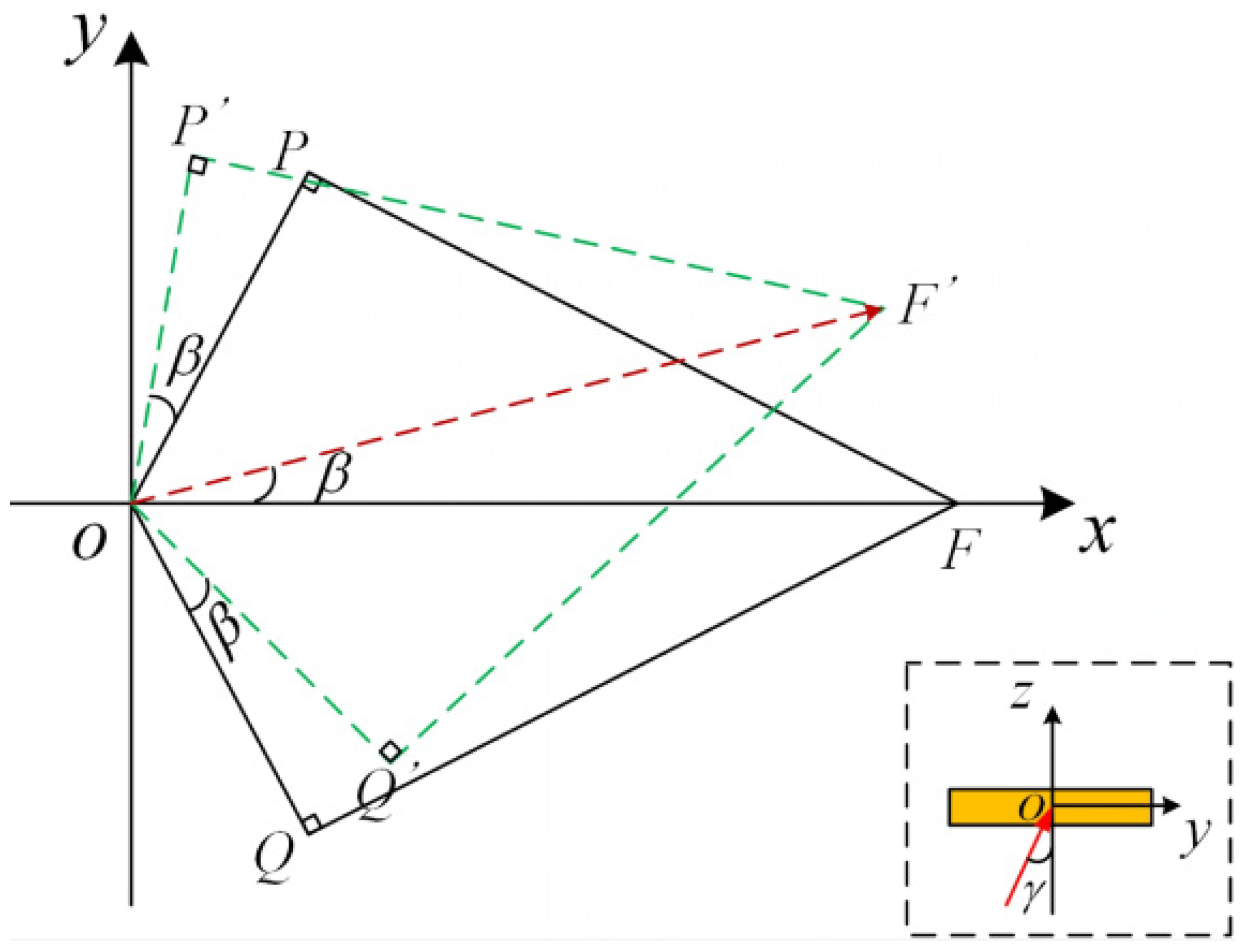
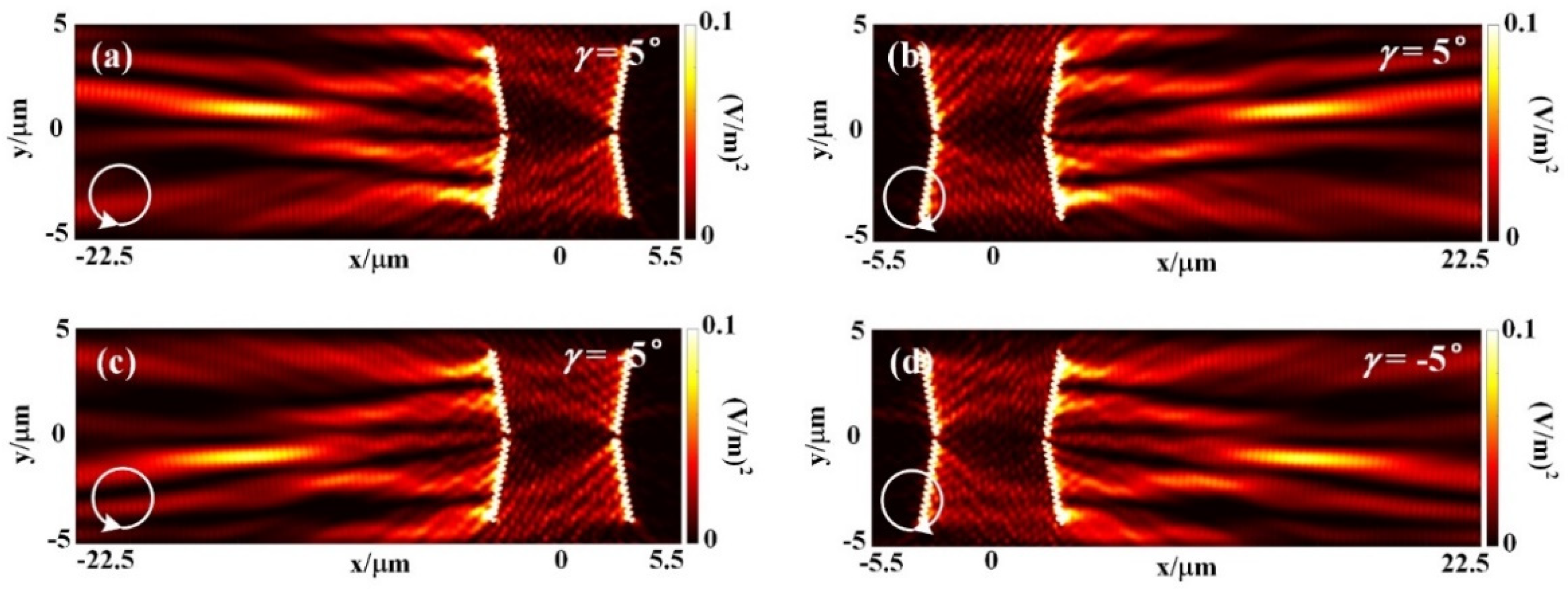
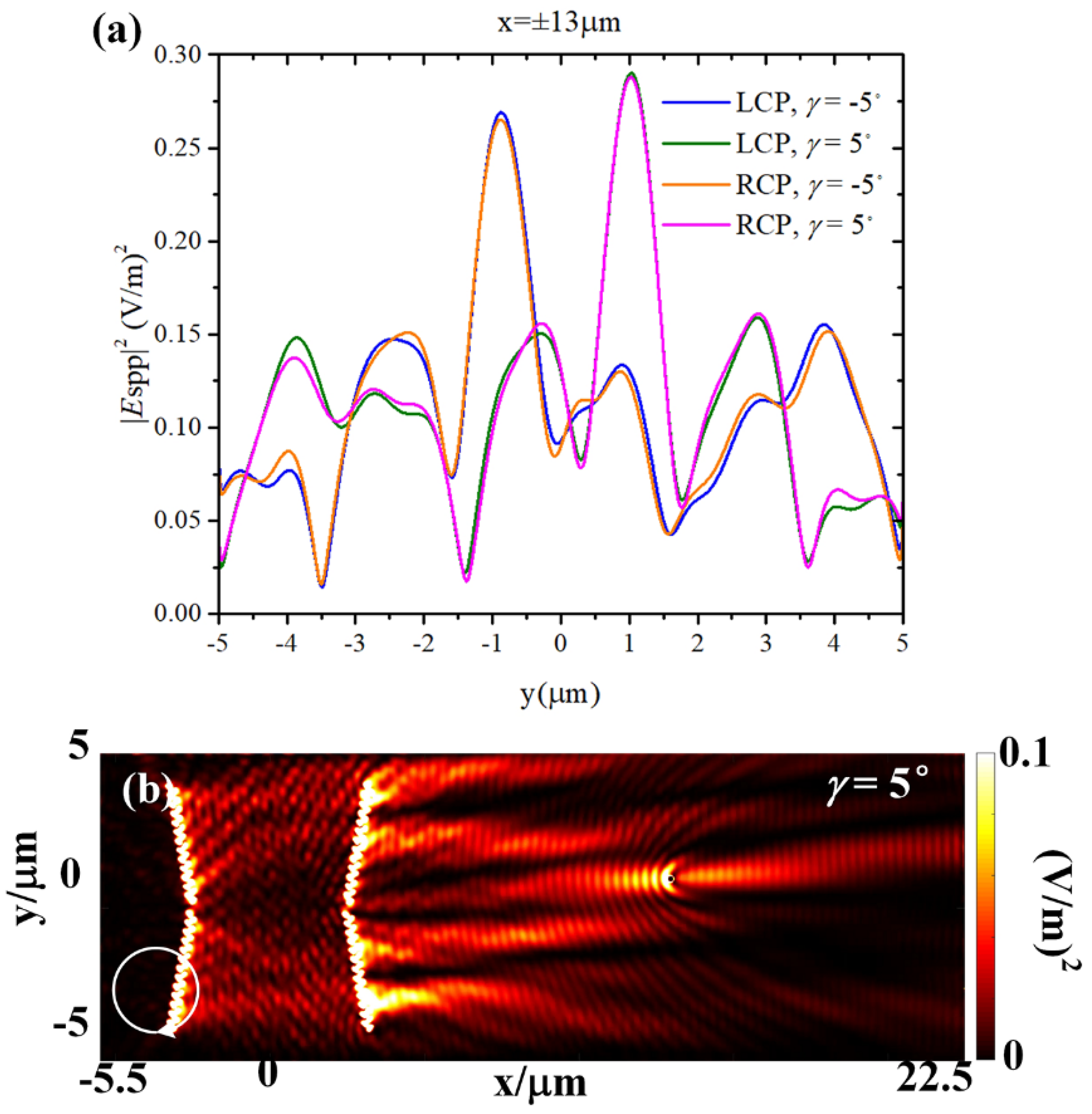



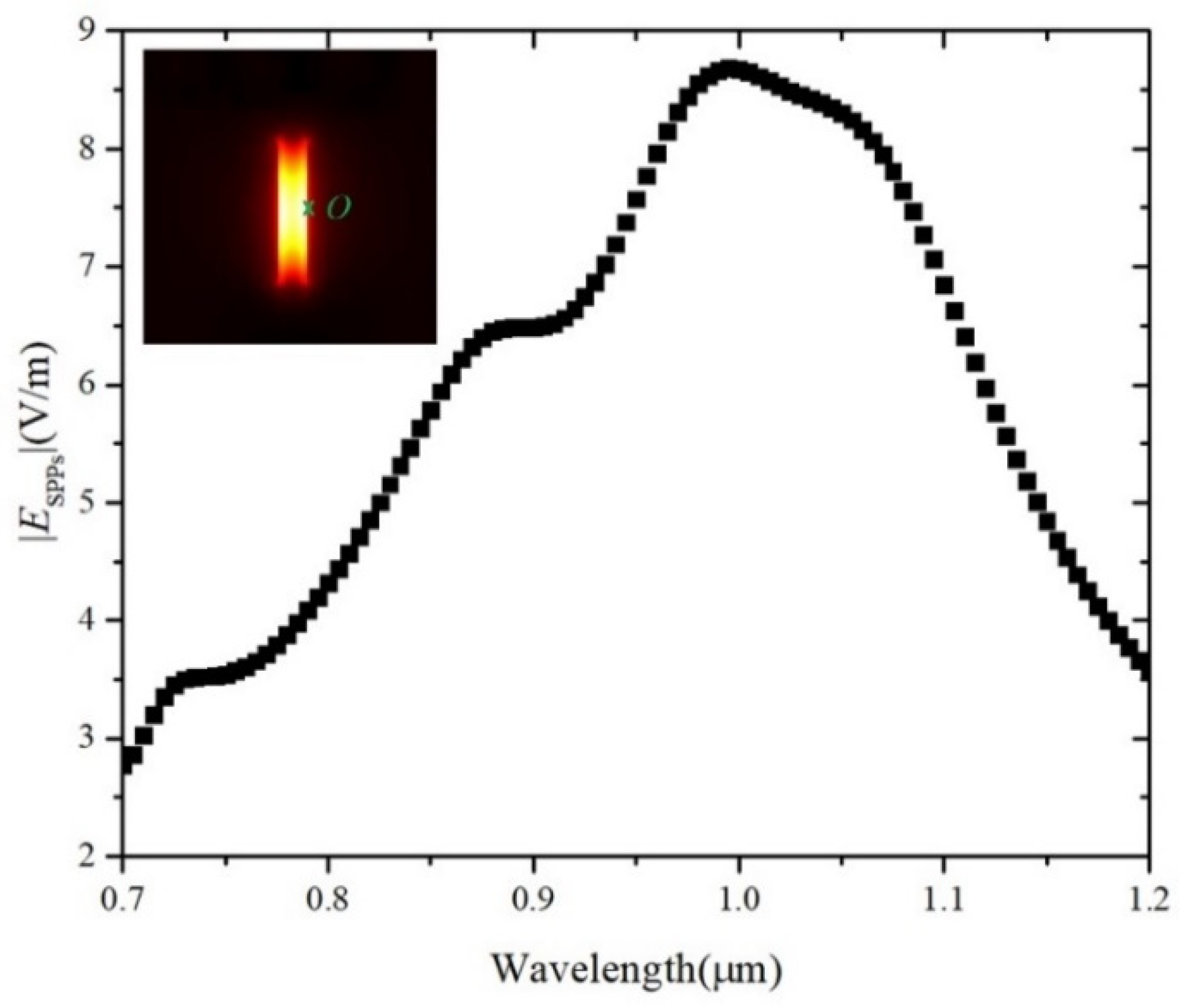
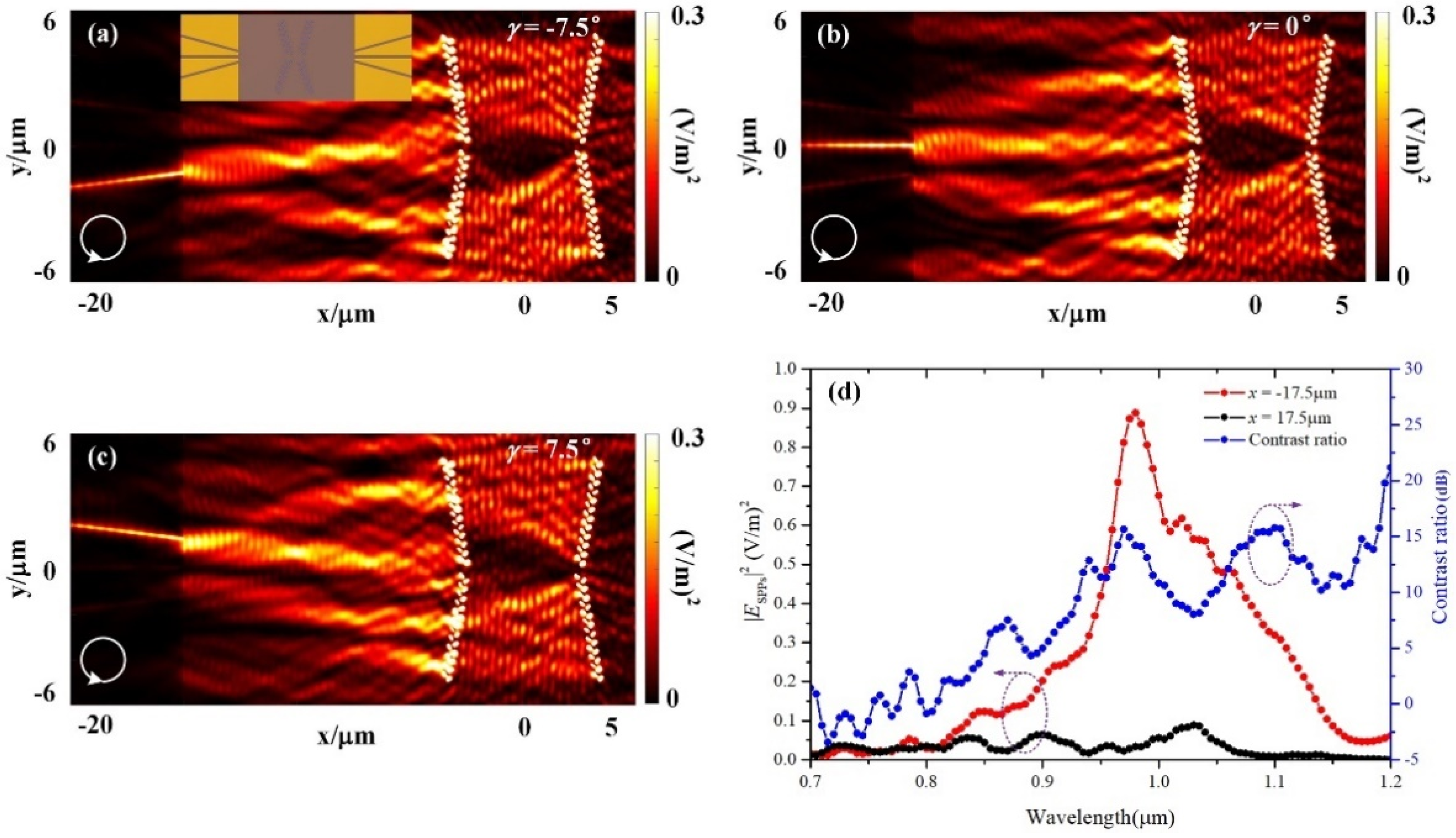
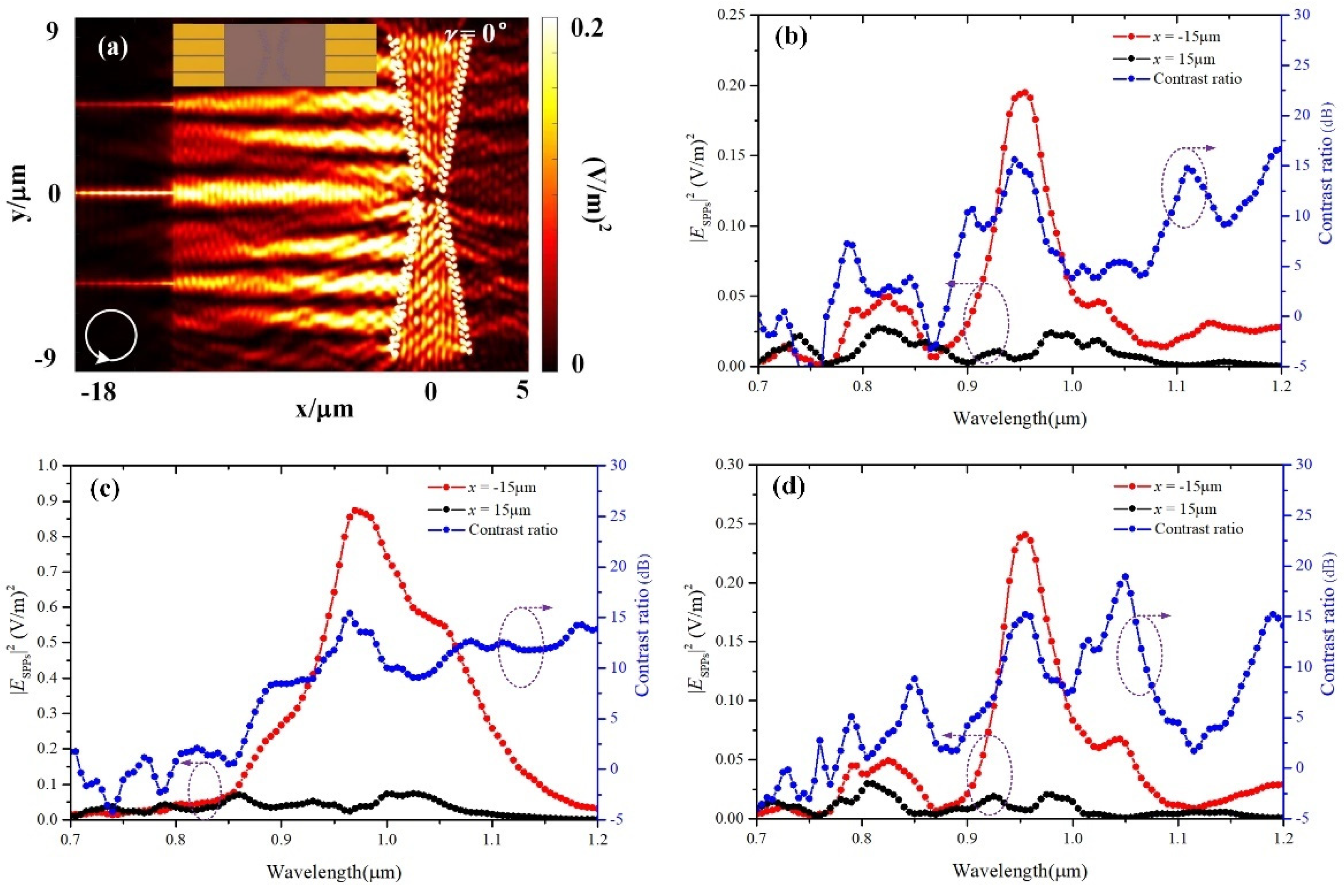
Publisher’s Note: MDPI stays neutral with regard to jurisdictional claims in published maps and institutional affiliations. |
© 2021 by the authors. Licensee MDPI, Basel, Switzerland. This article is an open access article distributed under the terms and conditions of the Creative Commons Attribution (CC BY) license (https://creativecommons.org/licenses/by/4.0/).
Share and Cite
Quan, Z.; Liu, H.; Yuan, L. Simulation of On-Chip Broadband Photon Spin Router Base on Nondiffracting Surface Plasmon Beam Launching. Appl. Sci. 2021, 11, 10643. https://doi.org/10.3390/app112210643
Quan Z, Liu H, Yuan L. Simulation of On-Chip Broadband Photon Spin Router Base on Nondiffracting Surface Plasmon Beam Launching. Applied Sciences. 2021; 11(22):10643. https://doi.org/10.3390/app112210643
Chicago/Turabian StyleQuan, Zhiqiang, Houquan Liu, and Libo Yuan. 2021. "Simulation of On-Chip Broadband Photon Spin Router Base on Nondiffracting Surface Plasmon Beam Launching" Applied Sciences 11, no. 22: 10643. https://doi.org/10.3390/app112210643




